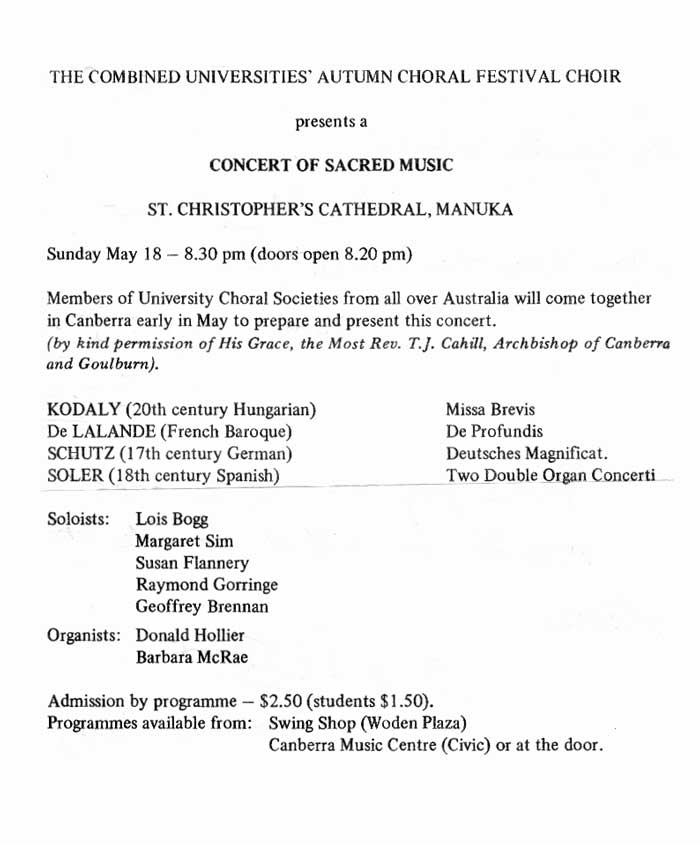

SCUNA history » IVs and Minifests hosted by SCUNA to 1988 » 1975 Minifest - MAYHEM - Concert
I have Brian Hingerty to thank for all the documents on this page. The originals are now in the safe keeping of the ANU Archives.
On this page: Concert flier | Concert programme | Canberra Times Review of the concert
On Organisation page: Eraticle 1 | Eraticle 2 | Bullsheet (page 3 only) | Rehearsal schedule

Sunday May 18 - 8.30 pm (doors open 8.20 pm)
Members of University Choral Societies from all over Australia will come together in Canberra early in May to prepare and present this concert.
(by kind permission of His Grace, the Most Rev. T.J. Cahill, Archbishop of Canberra and Goulburn).
| KODALY (20th century Hungarian) | Missa Brevis |
| De LALANDE (French Baroque) | De Profundis |
| SCHUTZ (17th century German) | Deutsches Magnificat |
| SOLER (18th century Spanish) | Two Double Organ Concerti |
| Soloists: | Lois Bogg |
| Margaret Sim | |
| Susan Flannery | |
| Raymond Gorringe | |
| Geoffrey Brennan | |
| Organists: | Donald Hollier |
| Barbara McRae |
Admission by programme - $2.50 (students $1.50).
Programmes available from: Swing Shop (Woden Plaza)
Canberra Music Centre (Civic) or at the door.
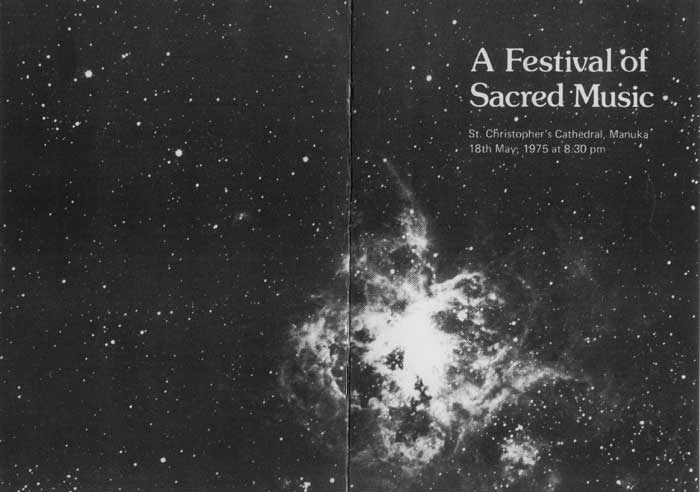
[Description: black cover with white stars and white text]
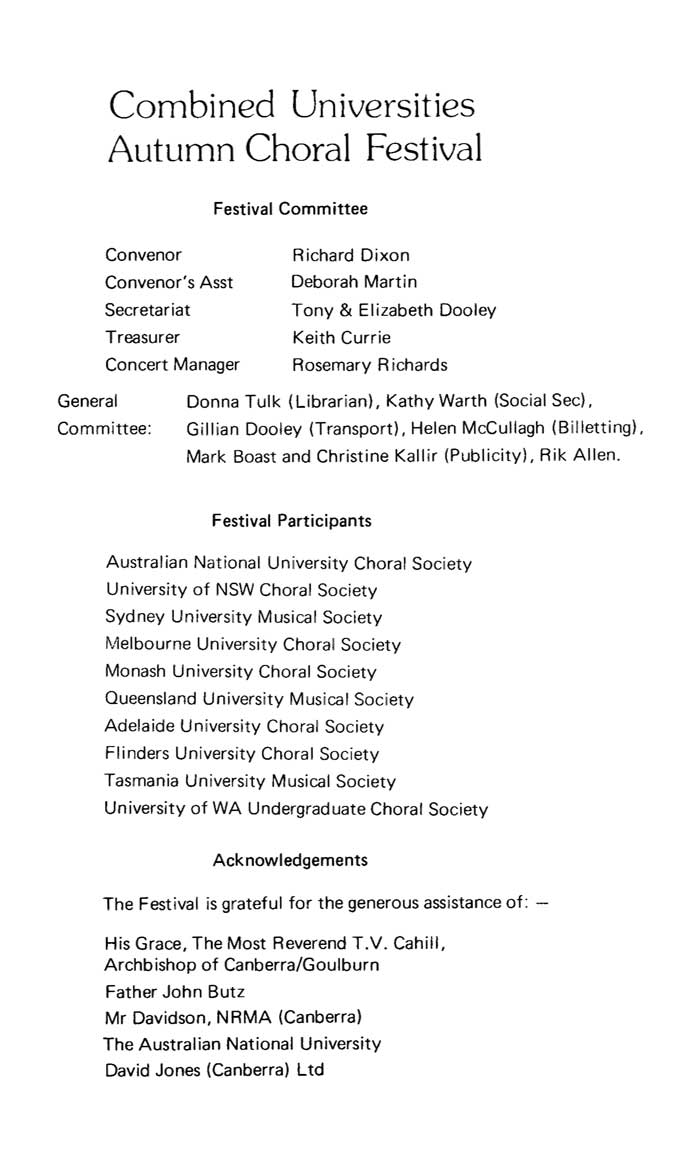
| Convenor | Richard Dixon |
| Convenor's Asst | Deborah Martin |
| Secretariat | Tony & Elizabeth Dooley |
| Treasurer | Keith Currie |
| Concert Manager | Rosemary Richards |
| General Committee | Donna Tulk (Librarian), Kathy Warth (Social Sec), Gillian Dooley (Transport), Helen McCullagh (Billeting), Mark Boast and Christine Kallir (Publicity), Rik Allen. |
The Festival is grateful for the generous assistance of:-
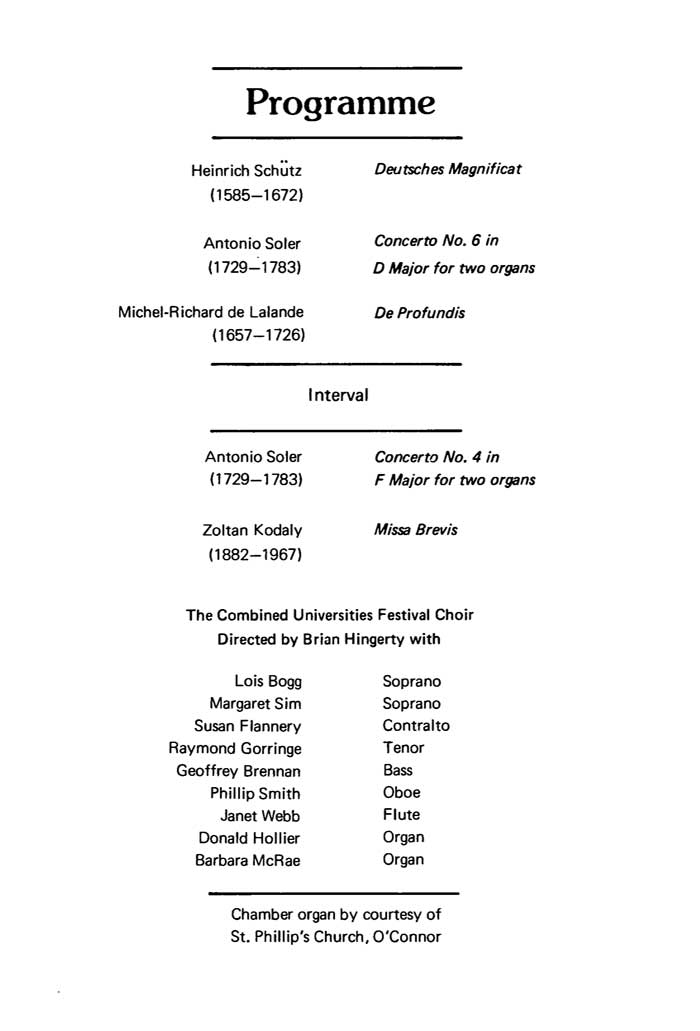
| Heinrich Schütz (1585 - 1672) |
Deutsches Magnificat |
| Antonio Soler (1729 - 1783) |
Concerto No. 6 in D Major for two organs |
| Michel-Richard de Lalande (1657 - 1726) |
De Profundis |
| Interval | |
| Antonio Soler (1729 - 1783) |
Concerto No. 4 in F Major for two organs |
| Zoltan Kodaly (1882 - 1967) |
Missa Brevis |
The Combined Universities Festival Choir
Directed by Brian Hingerty with
| Lois Bogg | Soprano |
| Margaret Sim | Soprano |
| Susan Flannery | Contralto |
| Raymond Gorringe | Tenor |
| Geoffrey Brennan | Bass |
| Phillip Smith | Oboe |
| Janet Webb | Flute |
| Donald Hollier | Organ |
| Barbara McRae | Organ |
Chamber organ by courtesy of St. Phillip's Church, O'Connor
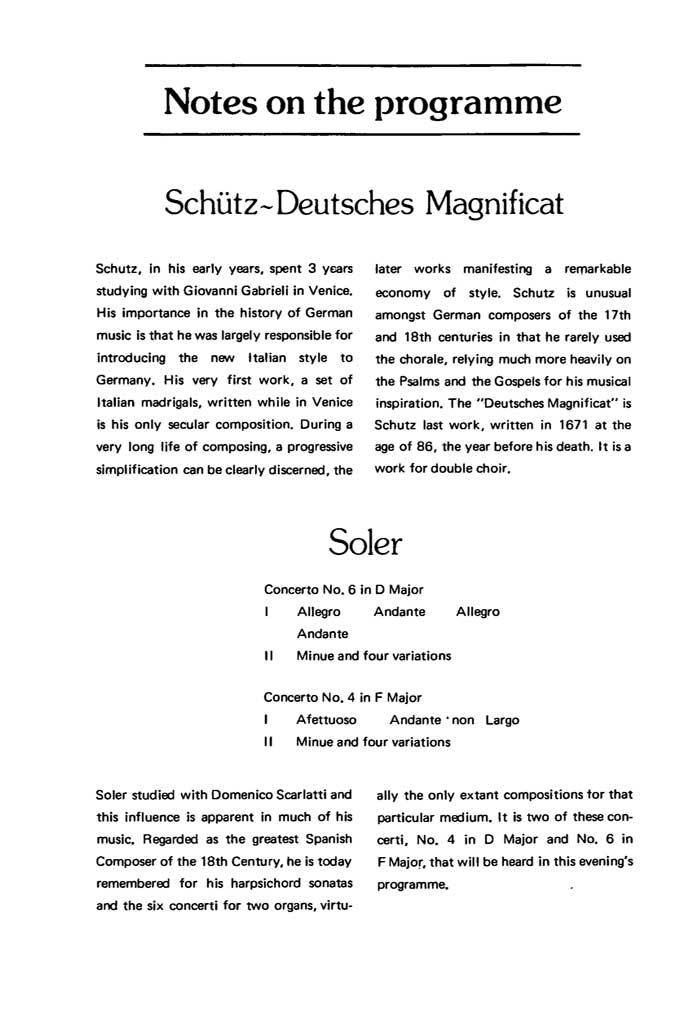
Schutz, in his early years, spent 3 years studying with Giovanni Gabrieli in Venice. His importance in the history of German music is that he was largely responsible for introducing the new Italian style to Germany. His very first work, a set of Italian madrigals, written while in Venice is his only secular composition. During a very long life of composing, a progressive simplification can be clearly discerned, the later works manifesting a remarkable economy of style. Schutz is unusual amongst German composers of the 17th and 18th centuries in that he rarely used the chorale, relying much more heavily on the Psalms and the Gospels for his musical inspiration. The Deutsches Magnificat is Schutz last work, written in 1671 at the age of 86, the year before his death. It is a work for double choir.
Concerto No. 6 in D Major
Concerto No. 4 in F Major
Soler studied with Domenico Scarlatti and this influence is apparent in much of his music. Regarded as the greatest Spanish Composer of the 18th Century, he is today remembered for his harpsichord sonatas and the six concerti for two organs, virtually the only extant compositions for that particular medium. It is two of these concerti, No. 4 in D Major and No. 6 in F Major, that will be heard in this evening's programme.
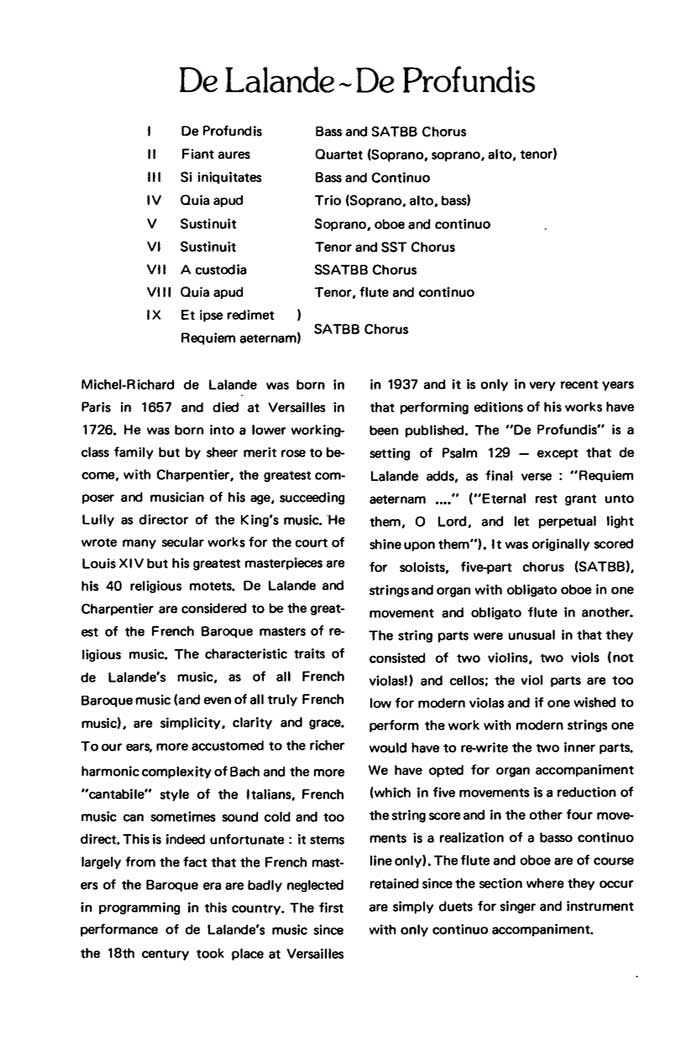
| I | De Profundis | Bass and SATBB Chorus |
| II | Fiant aures | Quartet (Soprano, soprano, alto, tenor) |
| III | Si iniquitates | Bass and Continuo |
| IV | Quia apud | Trio (Soprano, alto, bass) |
| V | Sustinuit | Soprano, oboe and continuo |
| VI | Sustinuit | Tenor and SST Chorus |
| VII | A custodia | SSATBB Chorus |
| VIII | Quia apud | Tenor, flute and continuo |
| IX | Et ipse redimet } Requiem aeternam} |
SATBB Chorus |
Michel-Richard de Lalande was born in Paris in 1657 and died at Versailles 1726. He was born into a lower working-class family but by sheer merit rose to become, with Charpentier, the greatest composer and musician of his age, succeeding Lully as director of the King's music. He wrote many secular works for the court of Louis XIV but his greatest masterpieces are his 40 religious motets. De Lalande and Charpentier are considered to be the greatest of the French Baroque masters of religious music. The characteristic traits of de Lalande's music, as of all French Baroque music (and even of all truly French music), are simplicity, clarity and grace. To our ears, more accustomed to the richer harmonic complexity of Bach and the more "cantabile" style of the Italians, French music can sometimes sound cold and too direct. This is indeed unfortunate: it stems largely from the fact that the French masters of the Baroque era are badly neglected in programming in this country. The first performance of de Lalande's music since the 18th century took place at Versailles in 1937 and it is only in very recent years in that performing editions of his works have been published. The De Profundis is a setting of Psalm 129 - except that de Lalande adds, as final verse: "Requiem aeternam ...." ("Eternal rest grant unto them, 0 Lord, and let perpetual light shine upon them"). It was originally scored for soloists, five-part chorus (SATBB), strings and organ with obligato oboe in one movement and obligato flute in another. The string parts were unusual in that they consisted of two violins, two viols (not violas!) and cellos; the viol parts are too low for modern violas and if one wished to perform the work with modern strings one would have to re-write the two inner parts. We have opted for organ accompaniment (which in five movements is a reduction of the string score and in the other four movements is a realization of a basso continuo line only). The flute and oboe are of course retained since the section where they occur are simply duets for singer and instrument with only continuo accompaniment.
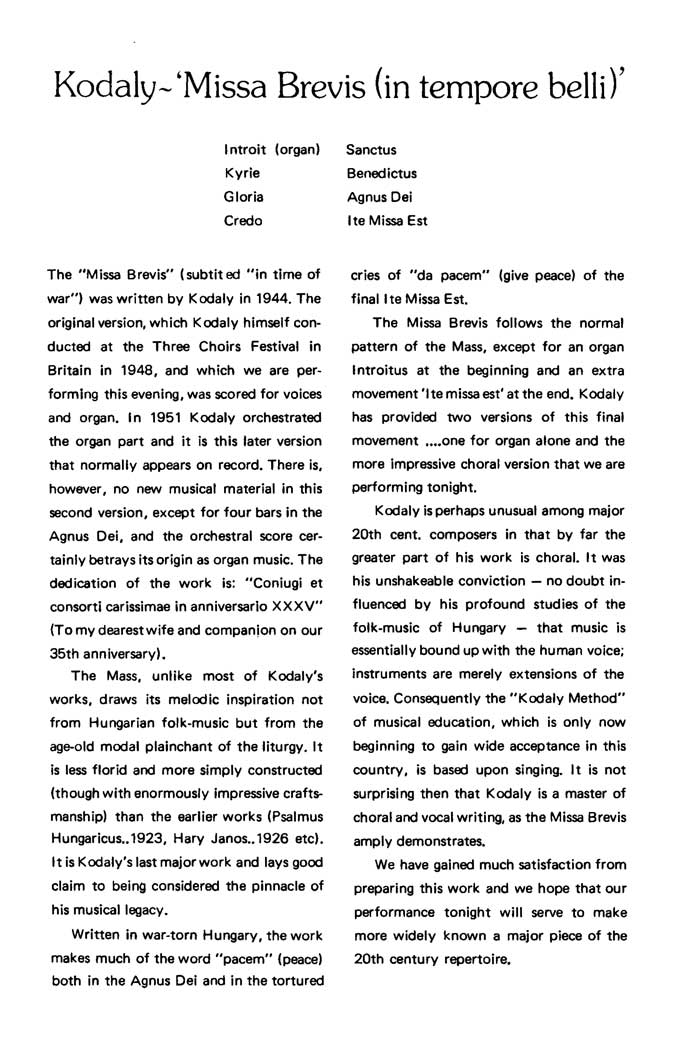
| Introit (organ) | Sanctus |
| Kyrie | Benedictus |
| Gloria | Agnus Dei |
| Credo | Ite Missa Est |
The Missa Brevis (subtitled "in time of war") was written by Kodaly in 1944. The original version, which Kodaly himself conducted at the Three Choirs Festival in Britain in 1948, and which we are performing this evening, was scored for voices and organ. In 1951 Kodaly orchestrated the organ part and it is this later version that normally appears on record. There is, however, no new musical material in this second version, except for four bars in the Agnus Dei, and the orchestral score certainly betrays its origin as organ music. The dedication of the work is: "Coniugi et consorti carissimae in anniversario XXXV" (To my dearest wife and companion on our 35th anniversary).
The Mass, unlike most of Kodaly's works, draws its melodic inspiration not from Hungarian folk-music but from the age-old modal plainchant of the liturgy. It is less florid and more simply constructed (though with enormously impressive craftsmanship) than the earlier works (Psalmus Hungaricus 1923, Hary Janos 1926 etc). It is Kodaly's last major work and lays good claim to being considered the pinnacle of his musical legacy.
Written in war-torn Hungary, the work makes much of the word "pacem" (peace) both in the Agnus Dei and in the tortured cries of "da pacem" (give peace) of the final Ite Missa Est.
The Missa Brevis follows the normal pattern of the Mass, except for an organ Introitus at the beginning and an extra movement "Ite missa est" at the end. Kodaly has provided two versions of this final movement ... one for organ alone and the more impressive choral version that we are performing tonight.
Kodaly is perhaps unusual among major 20th cent. composers in that by far the greater part of his work is choral. It was his unshakeable conviction - no doubt influenced by his profound studies of the folk-music of Hungary - that music is essentially bound up with the human voice; instruments are merely extensions of the voice. Consequently the "Kodaly Method" of musical education, which is only now beginning to gain wide acceptance in this country, is based upon singing. It is not surprising then that Kodaly is a master of choral and vocal writing, as the Missa Brevis amply demonstrates.
We have gained much satisfaction from preparing this work and we hope that our performance tonight will serve to make more widely known a major piece of the 20th century repertoire.
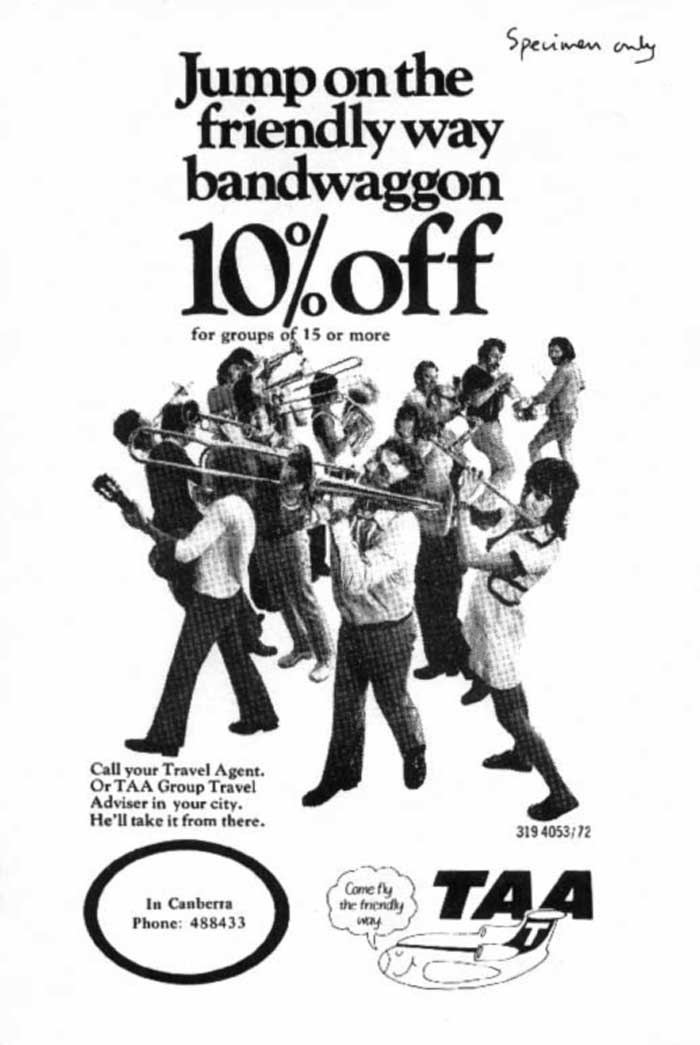
[Handwritten:] Specimen only
Jump on the friendly bandwaggon
10% off for groups of 15 or more
[Photo of people walking around with various musical instruments]
Call your travel agent. Or TAA Group Travel Adviser in your city. He'll [sic] take it from there.
In Canberra phone: 488433
TAA
Come fly the friendly way
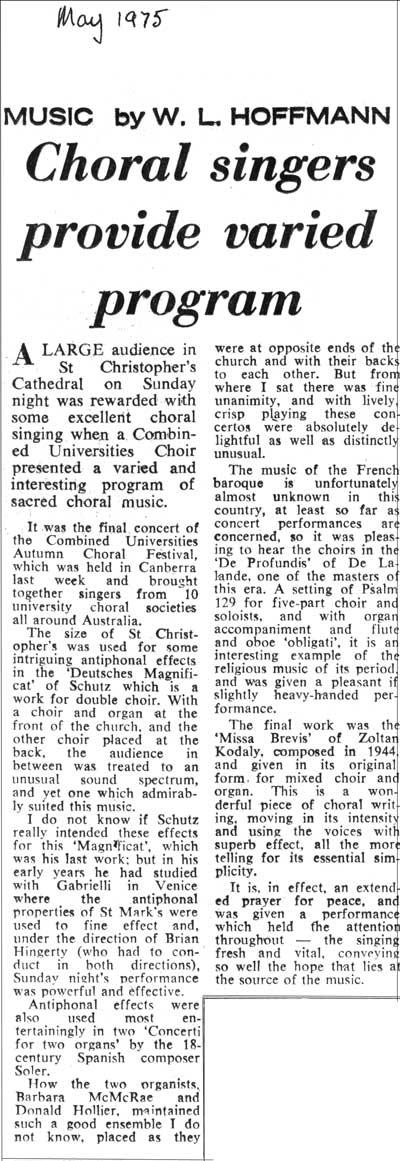
[Handwritten:] May 1975
A large audience in St Christopher's Cathedral on Sunday night was rewarded with some excellent choral singing when a Combined Universities Choir presented a varied and interesting program of sacred choral music.
It was the final concert of the Combined Universities Autumn Choral Festival, which was held in Canberra last week and brought together singers from 10 university choral societies all around Australia.
The size of St Christopher's was used for some intriguing antiphonal effects in the 'Deutsches Magnificat' of Schutz which is a work for double choir. With a choir and organ at the front of the church, and the other choir placed at the back, the audience in between was treated to an unusual sound spectrum, and yet one which admirably suited this music.
I do not know if Schutz really intended these effects for this 'Magnficat', which was his last work; but in his early years he had studied with Gabrielli in Venice where the antiphonal properties of St Mark's were used to fine effect and, under the direction of Brian Hingerty (who had to conduct in both directions), Sunday night's performance was powerful and effective.
Antiphonal effects were also used most entertainingly in two 'Concerti for two organs' by the 18-century Spanish composer Soler.
How the two organists, Barbara McRae and Donald Hollier, maintained such a good ensemble I do not know, placed as they were at opposite ends of the church and with their backs to each other. But from where I sat there was fine unanimity, and with lively, crisp playing these concertos were absolutely delightful as well as distinctly unusual.
The music of the French baroque is unfortunately almost unknown in this country, at least so far as concert performances are concerned, so it was pleasing to hear the choirs in the 'De Profundis' of De Lalande, one of the masters of this era. A setting of Psalm 129 for five-part choir and soloists, and with organ accompaniment and flute and oboe 'obligati', it is an interesting example of the religious music of its period, and was given a pleasant if slightly heavy-handed performance.
The final work was the 'Missa Brevis' of Zoltan Kodaly, composed in 1944, and given in its original form for mixed choir and organ. This is a wonderful piece of choral writing, moving in its intensity and using the voices with superb effect, all the more telling for its essential simplicity.
It is, in effect, an extended prayer for peace, and was given a performance which held the attention throughout - the singing fresh and vital, conveying so well the hope that lies at the source of the music.
-From the Canberra Times 19 May 1975,
according to Erato 17 of July 1975.